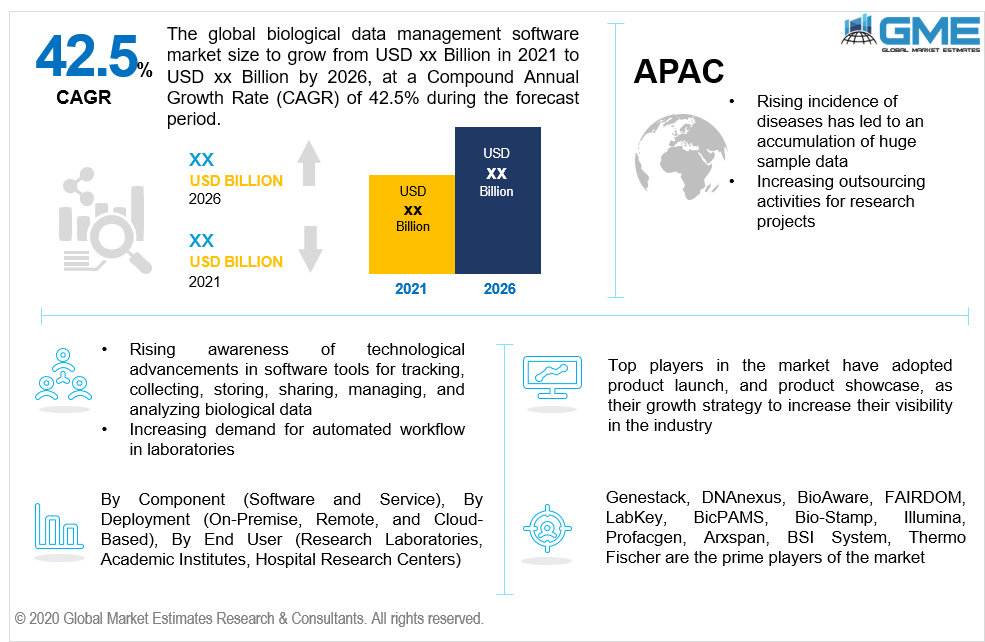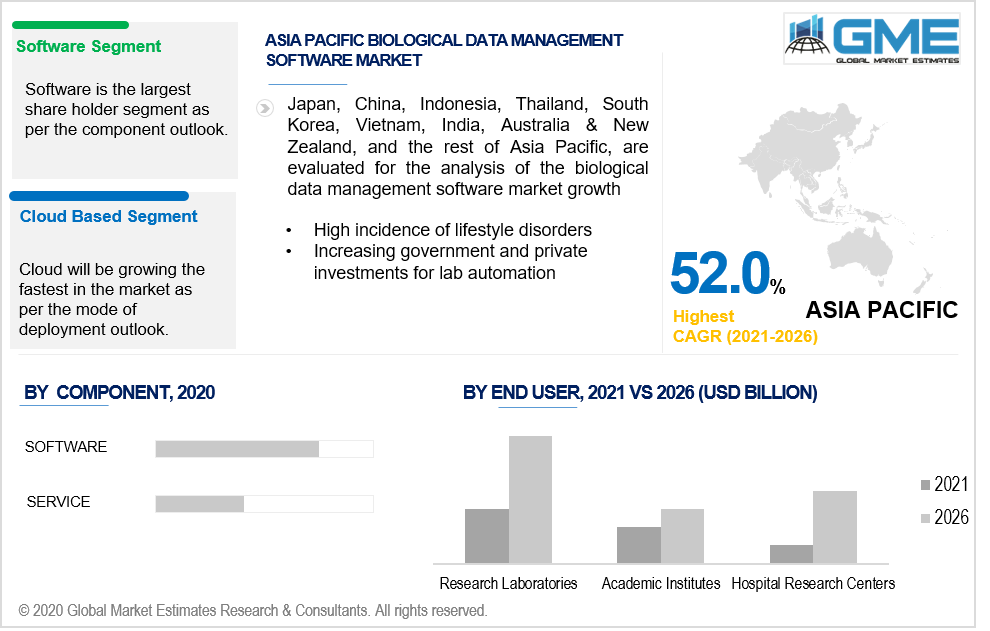
Global Biological Data Management Software Market Size, Trends & Analysis - Forecasts to 2026 By Component (Software and Service), By Deployment (On-Premise, Remote, and Cloud-Based), By End User (Research Laboratories, Academic Institutes, Hospital Research Centers), By Region (North America, Asia Pacific, CSA, Europe, and the Middle East and Africa); End-User Landscape, Company Market Share Analysis, and Competitor Analysis
Biological data can be of various types namely, protein sequence data, specialized database, genome data, and taxonomical data, database on organisms, secondary and primary data. Such data needs to be organized, collected, analyzed and presented logically to extract information efficiently. Hence, the market is witnessing the latest product launches and upgrades for biological data management software. Therefore, rising demand for automated workflow in laboratories, research institute, hospitals, and pharma & biotech firms, an increasing number of research and academic centers across the globe, rising awareness of technological advancements in software tools for tracking, collecting, storing, sharing, managing, and analyzing biological data are some of the major factors contributing the market growth. Moreover, due to the shortage of workforce to manage big data, most of the laboratories are adopting software systems. This in turn has helped the market flourish in recent times. The rising incidence of diseases has led to an accumulation of huge sample data, information, and patient records. This has also helped the market grow rapidly from 2021 to 2026.

Based on the component of this market, software and service are the two major segments considered for the study. However, the software segment will be the largest shareholder in the market in terms of revenue generation. This is attributed to increasing awareness for data management in the field of life science and healthcare industry, increasing purchasing power of various institutes for high-end software and databases, and increasing number of data due to high incidence of lifestyle disorders, and a high number of research activities.
Based on the mode of deployment the market can be segregated into on-premise, remote, and cloud-based systems. The on-premise segment will be the largest shareholder in the market mainly due to uniform and complete control over the software, high security against data breaching, and efficiency and ease in software installation.
Research laboratories, academic institutes, hospital research centers are the major end-users or customers for using such software. However, the research laboratories segment will be the dominant market segment owing to the increasing number of datasets, the rising number of in-house and outsourced research projects, and the advantage of remote data sharing capabilities.

Considering the high purchasing power, advanced laboratory automation, high awareness regarding data management, increasing number of research activities, the market for North America is ought to be a dominant segment as the geographical analysis is concerned. However, due to increasing outsourcing activities for research projects, rising incidence of lifestyle disorders, and increasing government and private investments for lab automation & efficacy, the market for the Asia Pacific will be growing the fastest from 2021 to 2026.
Genestack, DNAnexus, BioAware, FAIRDOM, LabKey, BicPAMS, Bio-Stamp, Illumina, Profacgen, Arxspan, BSI System, Thermo Fischer are the prime players of the market.
Please note: This is not an exhaustive list of companies profiled in the report.
In June 2019, Genestack launched Omics Data Manager, which is a data management software for indexing, searching cataloging, curating, and sharing biological information.
We value your investment and offer free customization with every report to fulfil your exact research needs.
The Global Biological Data Management Software Market has been studied from the year 2019 till 2026. However, the CAGR provided in the report is from the year 2021 to 2026. The research methodology involved three stages: Desk research, Primary research, and Analysis & Output from the entire research process.

The desk research involved a robust background study which meant referring to paid and unpaid databases to understand the market dynamics; mapping contracts from press releases; identifying the key players in the market, studying their product portfolio, competition level, annual reports/SEC filings & investor presentations; and learning the demand and supply side analysis for the Biological Data Management Software Market.

The primary research activity included telephonic conversations with more than 50 tier 1 industry consultants, distributors, and end-use product manufacturers.

Finally, based on the above thorough research process, an in-depth analysis was carried out considering the following aspects: market attractiveness, current & future market trends, market share analysis, SWOT analysis of the companies and customer analytics.

Tailor made solutions just for you
80% of our clients seek made-to-order reports. How do you want us to tailor yours?
OUR CLIENTS